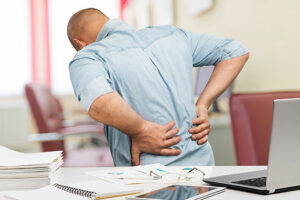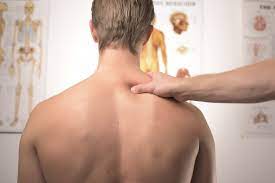Do you ever feel like there are lumps in your muscles? This is a common question, and there can be several different causes. In this blog post, we will discuss the most common reasons why your muscles might feel lumpy. We will also provide tips on how to get rid of the lumps and improve your muscle health!
Contents
Why Do My Muscles Feel Lumpy?
 It is common to feel lumps in your muscles, especially after working out. These lumps are usually nothing to worry about and will go away on their own. However, if you are concerned about the lumps, you can consult with a doctor to get a professional opinion. It is a feeling ofnodularity or firmness in the muscle that is not associated with pain.
It is common to feel lumps in your muscles, especially after working out. These lumps are usually nothing to worry about and will go away on their own. However, if you are concerned about the lumps, you can consult with a doctor to get a professional opinion. It is a feeling ofnodularity or firmness in the muscle that is not associated with pain.
It can occur anywhere in the body but is most commonly felt in the arms, legs, and trunk. There are many potential causes for feeling lumps in your muscles, including:
A build-up of lactic acid
Lactic acid is a by-product of exercise that can cause muscles to feel lumpy. The feeling is usually temporary and will go away on its own. It is a normal part of the muscle-building process. It can make muscles feel stiff and cause cramping.
Dehydration
Dehydration can cause your muscles to feel lumpy and dry. Because water makes up a large part of muscle tissue, when you’re dehydrated, your muscles can’t function properly and may feel hard to the touch. For example, you may feel a lump in your calf muscle after running a long distance, due to the loss of water and electrolytes through sweat.
Muscle cramps
It is not uncommon to feel lumpy muscles after strenuous activity. This is usually due to muscle cramps, which are caused by a build-up of lactic acid in the muscles. For example, after a long run, your muscles may feel hard and lumpy.
Injury
An injury to the muscle can cause it to feel lumpy. This is usually due to scar tissue forming around the injury site. It is believed that this scar tissue forms to help protect the injury from further damage.
Inflammation
Muscle inflammation can also cause the muscle to feel lumpy. This is because when the muscle is inflamed, it is filled with fluid and this can cause a lumpy feeling. Muscle inflammation can be caused by overuse, injury, or infection.
All in all, these are a few reasons why your muscles might feel lumpy. If you are concerned about the lumps in your muscles, it is best to consult with a doctor or physical therapist to rule out any serious causes. In most cases, the lumps are nothing to worry about and can be alleviated with simple self-care measures.
However, if the lumps are accompanied by pain, weakness, or other concerning symptoms, it is best to seek medical attention to rule out any serious causes.
What Are Some Symptoms?
 There are a few symptoms associated with myofascial trigger points, including:
There are a few symptoms associated with myofascial trigger points, including:
- Aching or burning pain: It is common for people to describe the pain associated with myofascial trigger points as a deep ache or burning sensation. The pain is often localized and can radiate outward to other areas of the body.
- Muscle tightness: Myofascial trigger points can cause muscles to feel tight and knotted.
- Limited range of motion: When myofascial trigger points are present, it can limit the range of motion of the affected muscle.
- Muscle weakness: In some cases, myofascial trigger points can cause muscles to feel weak and unable to generate the same amount of force as they normally would.
- Fatigue: This is a general feeling of tiredness that can be caused by myofascial trigger points.
- Cramping: It is not uncommon for people with myofascial trigger points to experience muscle cramping.
- Twitching: In some cases, myofascial trigger points can cause muscles to twitch or spasm.
- Difficulty sleeping: The pain and discomfort associated with myofascial trigger points can make it difficult to fall asleep or stay asleep.
More often than not, myofascial trigger points are the result of muscle tension or overuse. They can also develop due to injuries, such as whiplash or falls. In some cases, emotional stress can contribute to the development of myofascial trigger points.
While myofascial trigger points can occur in any muscle of the body, they are most commonly found in the shoulders, neck, back, and hips. It is important to identify these signs if you are feeling lumpy muscles for these reasons. Because when you are aware of the signs, you can better seek out help to find relief.
How To Get Rid Of Lumpy Muscles?
If you are working out regularly, then you might have experienced lumpy muscles at some point. This is quite a common phenomenon and is mostly seen in beginners who are not used to working out on a regular basis. However, even if you are a seasoned fitness enthusiast, you might still get lumpy muscles from time to time.
So, how can you treat lumpy muscles?
First of all, it is important to understand that lumpy muscles are not dangerous and they will not cause any harm to your body. In most cases, they are simply a result of your muscles adapting to your workout routine. As your muscles become more accustomed to the stress of exercise, the lumps will eventually go away on their own.
There are a few things that you can do to speed up the process of getting rid of lumpy muscles. Some of these are listed below:
Massage the affected area
 Massaging the lumpy muscles can help to break up the knots and make them feel less uncomfortable. You can use your fingers or a massage tool to massage the affected area for a few minutes at a time. Also, you can try taking a warm bath or using a heating pad to relax the muscles and reduce the discomfort.
Massaging the lumpy muscles can help to break up the knots and make them feel less uncomfortable. You can use your fingers or a massage tool to massage the affected area for a few minutes at a time. Also, you can try taking a warm bath or using a heating pad to relax the muscles and reduce the discomfort.
Stretch the muscles
Stretching the muscles can also help to get rid of lumpy muscles. To stretch the muscles, you can do some simple exercises like leg raises, arm swings, and shoulder shrugs. You can also try yoga or Pilates. These exercises can help to lengthen the muscles and make them more flexible.
Use a foam roller
A foam roller is a great way to self-massage your muscles and help break up knots and trigger points. It can also improve blood flow to the area and help with flexibility. When you feel like your muscles are lumpy, you should go ahead and roll out those kinks!
Use ice pack
Sometimes, lumps under the skin are caused by inflammation or injury. In these cases, using an ice pack may help reduce swelling and pain. For example, you can:
- Place an ice pack on the lump for 15-20 minutes at a time
- Repeat this several times per day
Take over-the-counter pain medications
 If you’re experiencing pain along with the lump, you may want to take over-the-counter (OTC) pain medications. These can help reduce inflammation and pain. Nonsteroidal anti-inflammatory drugs (NSAIDs), such as ibuprofen (Advil, Motrin) and naproxen sodium (Aleve), are available without a prescription.
If you’re experiencing pain along with the lump, you may want to take over-the-counter (OTC) pain medications. These can help reduce inflammation and pain. Nonsteroidal anti-inflammatory drugs (NSAIDs), such as ibuprofen (Advil, Motrin) and naproxen sodium (Aleve), are available without a prescription.
All in all, these are a few most common things that you can try if you ever experience a lump in your muscle. However, it’s still best to see a doctor to rule out any serious underlying conditions.
Conclusion
In conclusion, there are many possible explanations for why your muscles may feel lumpy. It could be due to a build-up of tension, inflammation, or a trigger point. If you’re concerned about the lumpiness of your muscles, it’s best to consult with a doctor or certified trainer to get an accurate diagnosis.
Because it is not unusual for muscles to feel lumpy, there is no need to be alarmed unless the lumps are accompanied by other symptoms such as pain, stiffness, or weakness. Therefore, do not hesitate to seek medical attention if you are concerned about your muscle lumpiness.
Physical Therapy help patients recover from pain. If you’re experiencing Back pain, Shoulder pain, Knee pain, Neck pain, Elbow pain, Hip pain, or Arthritis pain, a physical therapist at MantraCare can help: Book a physiotherapy session.


